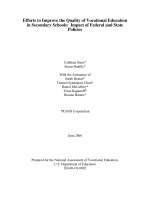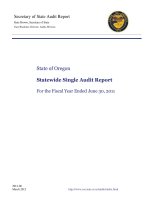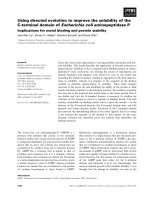Improve the filter of grid tide single phase inverter for rooftop photovoltaic systems
Bạn đang xem bản rút gọn của tài liệu. Xem và tải ngay bản đầy đủ của tài liệu tại đây (623.05 KB, 8 trang )
TNU Journal of Science and Technology
227(07): 65 - 72
IMPROVE THE FILTER OF GRID-TIDE SINGLE-PHASE INVERTER FOR
ROOFTOP PHOTOVOLTAIC SYSTEMS
Dinh Thi Sen1, Tran Ngoc Thien Nam2, Tran Anh Tuan3, Duong Minh Quan3*, Le Thi Minh Chau4
1Power
Engineering Consulting Joint Stock Company 4, 2Delta Electronic INC., Tainan,
University of Danang – University of Science and Technology,
4Hanoi University of Science and Technology
3The
ARTICLE INFO
Received: 22/3/2022
Revised: 25/4/2022
Published: 27/4/2022
KEYWORDS
Grid-tide
LCL filter
LLCL filter
THD
Rooftop PV
ABSTRACT
Renewable energy is becoming an alternative to conventional
generators in the context of increasing environmental pollution
problems. Countries gradually consider photovoltaic application a
necessary strategy for the sustainable development of modern power
systems. However, to connect the power system or supply power to
the load, the energy obtained from PV must convert through inverters.
That creates problems during the connection process as frequency
synchronization, and harmonics degrade power quality. This study
designs a complete grid-tied single-phase inverter model to look for a
high-quality inverter that can increase the quality of grid-connected
power and minimize harmonics with filters. The results show that the
connection voltage is kept stable with the proposed model and the
power quality is improved with different harmonic sets analyzed.
CẢI TIẾN BỘ LỌC CHO NGHỊCH LƯU MỘT PHA NỐI LƯỚI TRONG HỆ
THỐNG ĐIỆN MẶT TRỜI ÁP MÁI
Đinh Thị Sen1, Trần Ngọc Thiên Nam2, Trần Anh Tuấn3, Dương Minh Quân3*, Lê Thị Minh Châu4
ty Cổ phần Tư vấn và Xây dựng Điện 4, 2Tập đoàn Điện tử Delta, Đài Nam,
Đại học Bách khoa - Đại học Đà Nẵng,
4Trường Đại học Bách khoa Hà Nội
1Cơng
3Trường
THƠNG TIN BÀI BÁO
Ngày nhận bài: 22/3/2022
Ngày hồn thiện: 25/4/2022
Ngày đăng: 27/4/2022
TỪ KHĨA
Nối lưới
Bộ lọc LCL
Bộ lọc LLCL
THD
PV áp mái
TÓM TẮT
Năng lượng tái tạo đang trở thành giải pháp thay thế cho các nguồn
truyền thống trong bối cảnh vấn đề ô nhiễm môi trường ngày càng
gia tăng. Các nước dần coi việc tích hợp quang điện là một chiến
lược phát triển bền vững hệ thống điện hiện nay. Tuy nhiên, điện
năng từ nguồn năng lượng này cần phải được chuyển đổi thơng qua
biến tần để có thể nối lưới hoặc cung cấp cho phụ tải. Điều này địi
hỏi cần phải có các giải pháp cải thiện sự đồng bộ của tần số và giảm
thiểu sóng hài để đảm bảo chất lượng điện năng. Nghiên cứu này
thiết kế mơ hình biến tần một pha nối lưới hồn chỉnh nhằm mục đích
nâng cao chất lượng điện năng và giảm thiểu sóng hài thơng qua các
bộ lọc. Hơn nữa, hiệu quả của các bộ lọc sóng hài cũng được quan
tâm nghiên cứu.
DOI: />*
Corresponding author. Email:
65
Email:
TNU Journal of Science and Technology
227(07): 65 - 72
1. Introduction
CO2 effect reduction requirements are being applied closely with the commitment of countries
worldwide. As a result, conventional power sources have to be limited in generating capacity,
especially thermal and nuclear power plants, and gradually replaced by new power generation
technologies. Along with preferential policies and the urgent need for electricity demand,
renewable energy sources (RES) explode in installed and generation capacity. With various
installation forms, lower construction costs than other RESs, and many supportive policies,
photovoltaic (PV) gradually become essential for the modern electricity system [1]. Moreover,
PV is easily accessible to households in the form of the rooftop, which helps to reduce electricity
costs paid to power companies and can also earn profits from selling excess electricity [2], [3].
Since then, it has promoted the market share of rooftop PV, accounting for a significant part of
the generation rate structure.
Unlike large-capacity PV plants that are often concentrated, rooftop PV is decentralized and
connected to the low-voltage electricity grid. That makes coordinating and controlling electricity
difficult, significantly when the output power is constantly fluctuating by uncertainties of weather
conditions in different areas and times. Furthermore, rooftop PV can be integrated with different
phases in the low voltage distribution power system, which can cause the phase to unbalance in
the event of a fault. In addition, the power from PV must be converted through an inverter to
supply the load, which will create harmonics, causing power quality to degrade [4]. Therefore,
many studies have focused on planning and connecting rooftop PV systems to minimize the risk
of phase unbalance [5], [6]. Another approach proposes harmonic filters to improve the quality of
power obtained from PV, but most focus on isolated inverters [7].
This study proposes a grid-tied inverter model, calculates, and designs filters to improve
power quality, operating with stable voltage when connected to the grid. The maximum energy
from PV is collected via a DC/DC converter with maximum power point tracking (MPPT)
algorithm and then converted through the gird-tied inverter. The harmonic filter types will be
reviewed, simulated, and improved with a complete inverter via Matlab/Simulink [8]. From there,
an appropriate solution can be given to improve the power quality of rooftop PV systems.
In the following sections of this paper, the grid-harmonized inverter model will be mentioned
in part 2. Then, the harmonic filters will be calculated in part 3. Finally, the comparison and
evaluation results can be presented in section 4, and the conclusions are considered in section 5.
2. Grid-tied Inverter Model
The single-phase grid-connected inverter model is combined from DC/DC and DC/AC
converters. Firstly, the PFSB DC/DC converter ensures 2 functions of changing the switching
frequency of the semiconductor valves to bring the unstable DC voltage of the renewable energy
back to a stable DC voltage at 700V and integrates the MPPT algorithm to optimize the power
obtained from PV. The H-bridge inverter consists of 4 IGBT control keys that convert the DC
gain voltage into AC voltage. The IGBT opens and closes, synchronizes energy with the grid
voltage and frequency, and goes through a filter to reduce harmonics, creating the best quality
power before connecting to the low voltage distribution power system. The overview model is
shown in Figure 1 [5], [6], with the specification as Table 1. The converter simulation model in
Matlab is shown in Figure 2 [8].
Figure 1. Block diagram of grid-connected inverter [5], [6]
66
Email:
TNU Journal of Science and Technology
227(07): 65 - 72
Table 1. System specification
Factor
1
2
3
4
5
6
7
8
9
Specification
DC/DC input voltage
DC/DC out voltage
DC/AC input voltage
Rated power
DC/DC switch frequency
DC/AC switch frequency
Grid frequency
AC rated current
DC rated current
Rated value
350-450VDC
700VDC (600 -800VAC)
220VAC
6kW
17kHz
35kHz
50Hz
27,27 A
8,57A
Figure 2. Modeling of DC/DC PSFB combined Full-Bridge inverter unit in Simulink
3. Integrated Filters for Grid-Tied Inverter
3.1. LCL type
The LCL type filter is designed as Figure 3 with the total inductance of the two inductors, L1
and L2, should be less than 10% of the base inductor of the system to avoid large voltage drop [9],
[10]. The current fluctuation IRipple is limited to 20% of rated current, from which inverter side
inductor L1 is selected based on a maximum allowable ripple of ΔIRipple current as in equation (1):
Vin
Vin
L1 =
=
(1)
4 f s I Ripple 4 f s 20% I in
Where: Vin and Iin are the rated input voltage and current of the inverter, respectively; fs is the
sampling frequency, also known as the switching frequency of the semiconductor valve.
Figure 3. LCL filter in Simulink
The total inductance value of the filter is determined by equation (2) based on the condition of
the maximum voltage drop across the inductor, which is limited to about 10% of the rated grid
voltage Vgrid:
2
10%Vgrid
10%Vgrid
10%Vgrid
L1 + L2 =
=
=
(2)
2 I out f 2 S f 2 S f
Vgrid
Where: S and Iout are the output power and current of the inverter, respectively, with the grid
frequency f.
67
Email:
TNU Journal of Science and Technology
227(07): 65 - 72
From there, the value of inductor L2 is determined:
2
10%Vgrid
(3)
L2 =
− L1
2 S f
The filter capacitor is designed to limit the variation of the reactive source. The reactive power
absorbed by the filter capacitor is limited to 5%S. A small capacitance will reduce the attenuation
of the LCL filter, while a high value leads to resonance in the inverter. This value is calculated
from (4):
Q
0,05S
C=
=
(4)
2
2
2 Vgrid
f 2 Vgrid
f
During the calculation, the resonant frequency of the LCL filter is calculated using equation
(5) and should be in the range (6). The L2 side inductor value should only be a part of L1 to ensure
stability and limit, according to IEEE 519 [11]. The parasitic resistance of inductors and
capacitors can be ignored since their values in the filter are relatively small and do not affect too
much energy loss and voltage drop. In addition, the selection of element values must satisfy the
resonant frequency value as (5):
L1 + L2
1
f res =
(5)
2 L1 L2 C
10 f g fres 0,5 f s
(6)
LCL filters may contain a shock-reducing resistor Rd to avoid resonances and have a value of
one-third of the impedance of the filter capacitor. Shock absorbing resistors are placed in parallel
or series with the filter capacitor.
1
1
Rd =
(7)
3 2 f res C
3.2. LLCL Type
A high-performance source filter topology for mains voltage power inverters is called LLCL
to improve high-order harmonics rejection [12], [13]. Based on the traditional LCL filter, a small
inductor is added into the branch loop of the capacitor, as shown in figure 4, creating a series
resonant circuit at the switching frequency fres. This filter model can better attenuate switching
frequency current ripple components than the LCL filter.
Figure 4. LLCL filter in Simulink
The constraints of the LCL and LLCL filters are the same [8]. So the values of L1, L2, and C
are chosen to be the same with LCL. Reactive power limit corresponding to equations (1), (2),
(3), and (4). There is one more inductor L3 connected in series with capacitor C, the resonant
frequency fres in equation (5) is calculated as:
f res =
1
2
L1 + L2
1
=
L1 L2 C 2 L3 C
68
(8)
Email:
TNU Journal of Science and Technology
227(07): 65 - 72
The inductance value L3 is found based on (9):
L3 =
1
(9)
( 2 f res ) C
2
The total resonant frequency of the filter of LICL type is shown in (10):
f res _ total =
1
L1 L2
2
L3 C
L1 + L2
(10)
Similar to the LCL filter, the shock damping resistance Rd of the LLCL filter is determined:
1
1
Rd =
(11)
3 2 f res _ total C
4. Simulation Results
To accurately evaluate the filter efficiency, the calculation and simulation are guaranteed to be
performed under the same conditions summarized in Table 2.
Table 2. Filter parameters
Factor
L1
L2
C
Fres
L3
Fres’
Rd
LCL
648.5 μH
3.08 μH
19.73 μF
1584 Hz
/
/
1.7Ω
LLCL
648.5 μH
3.08 μH
19.73 μF
1584 Hz
511.69 μH
1120 Hz
2.4Ω
For the LCL filter type, results of the output current waveform are shown in Figure 5. The
current can be seen before passing through the filter corresponding to the green line with high
flicker due to the wave components. That is because harmonics have not been removed and can
hardly be supplied to the load. After power has passed via the filter, the red response shows that
most of the higher-order harmonics have been eliminated, but the peak is still distorted due to the
inability to remove all the harmonics.
Figure 5. Output current waveform of inverter with LCL filter
Similarly, with the LLCL filter, when the current has not passed, the green current wave
represents the result before filtering, and the red response is the current after passing the
harmonic filter in the figure 6. The output waveform is obtained as close to the standard sine. At
the same time, the wave peak does not have as significant distortion as the LCL filter.
69
Email:
TNU Journal of Science and Technology
227(07): 65 - 72
Figure 6. Output current waveform of inverter with LLCL filter
The difference in output response between the two filters is shown in figure 7 determines the
effective filtering level of LLCL compared with LCL. Green response in case of using LLCL
filter near the standard response in blue line and the deviation is almost zero. Meanwhile, the red
response of the LCL filter, whose amplitude is lower than the standard value in unison, can see
the wave deflection of the current to be able to see in more detail. The distribution of harmonic
components (THD) can be observed in figure 8.
Figure 7. Differential output current value before and after filter improvement
Figure 8. THD comparison between LCL and LLCL filters
The harmonic distribution again shows the filtering quality of the LLCL. THD level achieved
is 1.45% compared to 3.37% of the LCL. Considering IEEE 519-1992 and IEC 61000 [11]-[14],
the allowable THD level for voltages below 1kV is 5% and below 69kV is 3%. However, many
countries still require the 3% limit. With this condition, the grid-tied inverter with the LCL filter
70
Email:
TNU Journal of Science and Technology
227(07): 65 - 72
can hardly meet the requirements for grid-connected power quality. In addition, with the 2nd
harmonic, the most dangerous component for the system, LLCL gives better filter quality and
other harmonic orders.
5. Conclusion
This paper has designed a grid-tied single-phase inverter model using Matlab/Simulink
integrating different types of harmonic filters for rooftop PV systems. With rooftop PVs always
affected by unpredictable weather conditions that make the energy output dynamic, the
construction model maintains voltage and current stability through the converter.
The careful selection of the filter element and the simulation results have shown that the
performance of the proposed LLCL filter is improved from the LCL filter. The level of waveform
distortion caused by harmonics is almost eliminated, and the TDH value meets IEEE/ANSI and
IEC grid connection standards. However, research to improve power quality for installed PV
systems needs to be further developed in terms of inverter control and considering three-phase
inverters for applications with larger power sources.
Acknowledgment
This research was funded by the Ministry of Education and Training under project number CT
2022.07.DNA.06.
REFERENCES
[1] M. Q. Duong, N. T. N. Tran, G. N. Sava, and M. Scripcariu, “The Impacts of Distributed Generation
Penetration into the Power System,” 2017 International Conference on Electromechanical and Power
Systems (SIELMEN), 2017, pp. 295-301.
[2] M. Q. Duong, N. Thien, N. A. M. Tran, G. N. Sava, and V. Tanasiev, “Design, performance and
economic efficiency analysis of the photovoltaic rooftop system,” Rev. Roum. Scie. – Techn.
Électrotechn. et Énerg., vol. 64, no. 3, pp. 229-234, 2019.
[3] A. Routray, K. D. Mistry, S. R. Arya, and B. Chittibabu, "Power output evaluation of a wind–solar farm
considering the influence parameters," IET Renewable Power Generation, vol. 15, no. 8, pp. 16131623, 2021.
[4] H. Cha and T. K. Vu, “Study and Design of L-C-L Filter for Single-Phase Grid-Connected PV
Inverter”, The Korean Institute of Electrical Engineers' Conference, 2009, pp. 228-230.
[5] L. Wang, R. Yan, and T. K. Saha, "Voltage regulation challenges with unbalanced PV integration in
low voltage distribution systems and the corresponding solution," Applied Energy, vol. 256, p. 113927,
2019.
[6] Q. Nguyen, H. V. Padullaparti, K.-W. Lao, S. Santoso, X. Ke, and N. Samaan, "Exact optimal power
dispatch in unbalanced distribution systems with high PV penetration," IEEE Transactions on Power
Systems, vol. 34, no. 1, pp. 718-728, 2018.
[7] M. Q. Duong, V. T. Nguyen, A. T. Tran, G. N. Sava, and T. M. C. Le, “Performance assessment of
low-pass filters for standalone solar power system,” in 2018 International Conference and Exposition
on Electrical and Power Engineering (EPE) (Iasi), 2018b, pp. 503-507, doi:
10.1109/ICEPE.2018.8559942
[8] Mathworks,
“Single-phase
PWM
Inverter”,
2021
[Online].
Available:
[Accessed Oct. 20,
2021].
[9] N. F. Roslan, J. A. Suul, A. Luna, I. Candela, and P. Rodriguez, "A simulation study of proportional
resonant controller based on the implementation of frequency-adaptive virtual flux estimation with the
LCL filter," IECON 2015 - 41st Annual Conference of the IEEE Industrial Electronics Society, 2015,
pp. 001934-001941, doi: 10.1109/IECON.2015.7392383.
[10] W. Wu, Y. He, T. Tang, and F. Blaabjerg, “A New Design Method for the Passive Damped LCL and
LLCL Filter-Based Single-Phase Grid-Tied Inverter,” IEEE transactions on industrial electronics, vol.
60, no. 10, pp. 4339-4350, October 2013.
71
Email:
TNU Journal of Science and Technology
227(07): 65 - 72
[11] IEEE Recommended Practice and Requirements for Harmonic Control in Electric Power Systems,
IEEE Standard 519, 2014.
[12] M. Huang, X. Wang, P. C. Loh, and F. Blaabjerg, "Design of LLCL-filter for grid-connected
converter to improve stability and robustness," 2015 IEEE Applied Power Electronics Conference and
Exposition (APEC), 2015, pp. 2959-2966, doi: 10.1109/APEC.2015.7104772.
[13] W. Wu, Y. He, and F. Blaabjerg, “An LLCL Power Filter for Single-Phase Grid-Tied Inverter”, IEEE
transactions on power electronics, vol. 27, no. 2, pp. 782-789, February 2012.
[14] Amendment 1 - Electromagnetic compatibility (EMC) - Part 3-2: Limits - Limits for harmonic current
emissions (equipment input current ≤16 A per phase), IEC Standard 61000-3-2, 2018.
72
Email:









